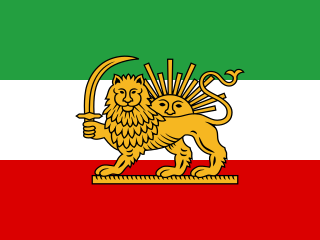
The history of Iran, which was commonly known until the mid-20th century as Persia in the Western world, is intertwined with the history of a larger region, also to an extent known as Greater Iran, comprising the area from Anatolia, the Bosphorus, and Egypt in the west to the borders of Ancient India and the Syr Darya in the east, and from the Caucasus and the Eurasian Steppe in the north to the Persian Gulf and the Gulf of Oman in the south.

Azerbaijani or Azeri, sometimes also Azeri Turkic or Azeri Turkish, is a term referring to two Turkic lects that are spoken primarily by the Azerbaijanis, who live mainly in Transcaucasia and Iran. Caucasian Azerbaijani and Iranian Azerbaijani have significant differences in phonology, lexicon, morphology, syntax, and sources of loanwords. ISO 639-3 groups the two lects as a "macrolanguage".

The Qajar Empire, also referred to as Qajar Iran, officially the Sublime State of Persia, was the state ruled by the Qajar dynasty, an Iranian royal dynasty of Turkic origin, specifically from the Qajar tribe, from 1789 to 1925. The Qajar family took full control of Iran in 1794, deposing Lotf 'Ali Khan, the last Shah of the Zand dynasty, and re-asserted Iranian sovereignty over large parts of the Caucasus. In 1796, Mohammad Khan Qajar seized Mashhad with ease, putting an end to the Afsharid dynasty, and Mohammad Khan was formally crowned as Shah after his punitive campaign against Iran's Georgian subjects. In the Caucasus, the Qajar dynasty permanently lost many of Iran's integral areas to the Russians over the course of the 19th century, comprising modern-day Georgia, Dagestan, Azerbaijan and Armenia.

Naqadeh, also known as Naghadeh, Naghdeh and Nagadeh, is a city in and the capital of Naqadeh County, West Azerbaijan Province, Iran. At the 1996 census, its population was 110,257, in 20,781 families.

Bulanık, formerly Gop or Kop, is a town and district of Muş Province in the Eastern Anatolia region of Turkey.

The Qarapapaqs or Karapapaks are a Turkic sub-ethnic group of Azerbaijanis who mainly live in Azerbaijan, Iran, Georgia, and in the northeast of Turkey near the border with Georgia and Armenia, primarily in the provinces of Ardahan, Kars and Ağri. The exact number for the Qarapapaq population worldwide is unknown but is likely to be in the hundred thousands.

Tsaghkut, is a village in the Shirak Province of Armenia.

Zarishat is a village in the Shirak Province of Armenia.

Zorakert is a village in the Shirak Province of Armenia.

The Battle of Ganja, Siege of Ganja Fortress or Assault on Ganja, was the result of a Russian offensive in the South Caucasus intended to conquer the Ganja Khanate, which contributed to the escalation of the Russo-Persian War (1804–1813).
The terms People of the Caucasus and Caucasian people indicate two main groups of people in Iran:
Leman Bozkurt Altınçekiç (1932–2001) was the first female accredited jet pilot in Turkish Air Force and NATO.










